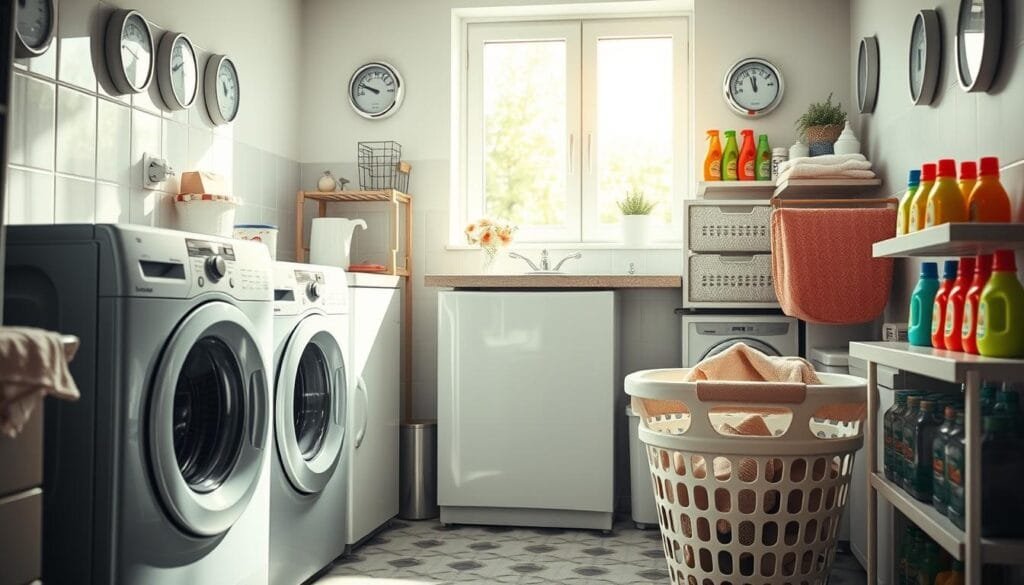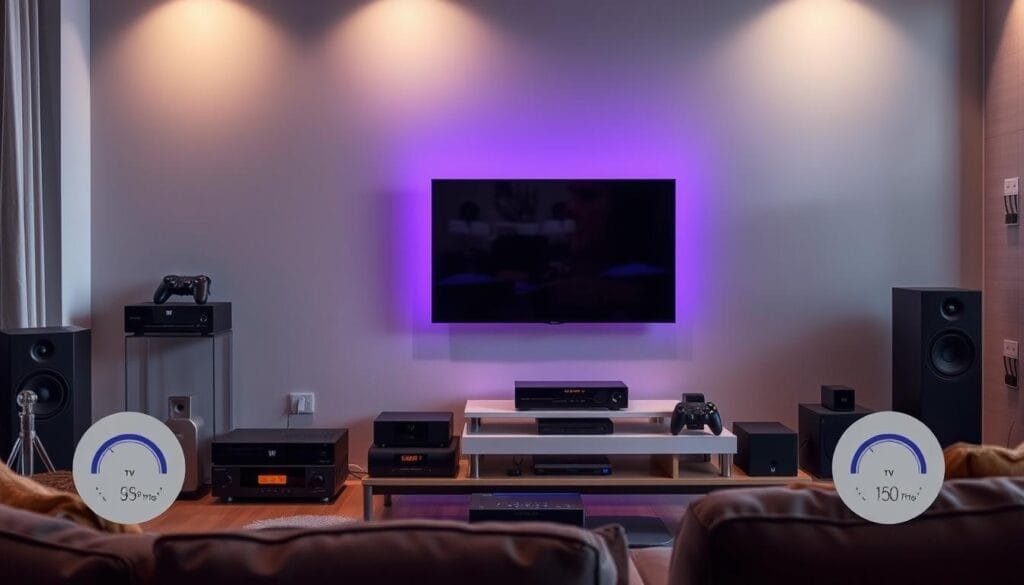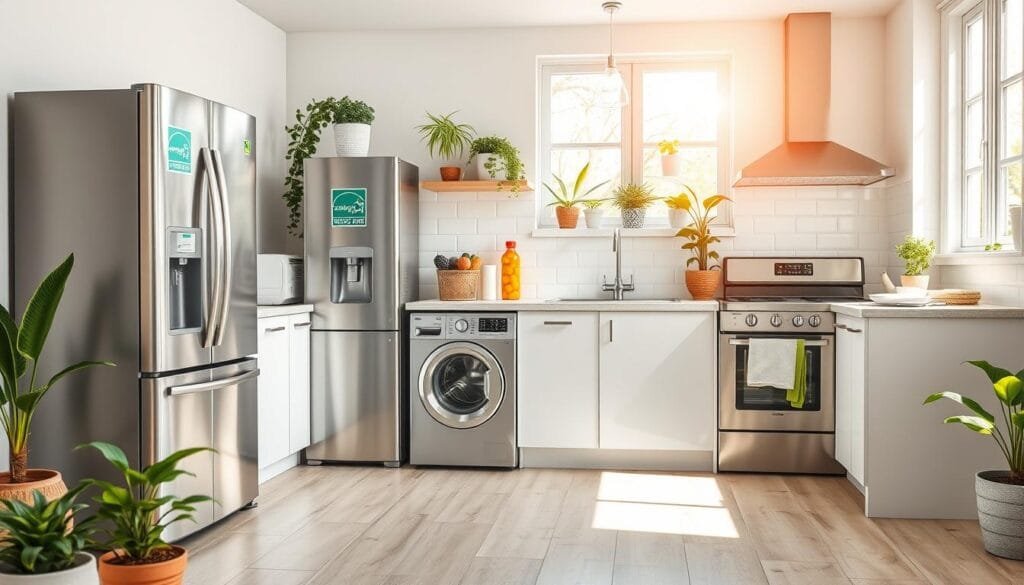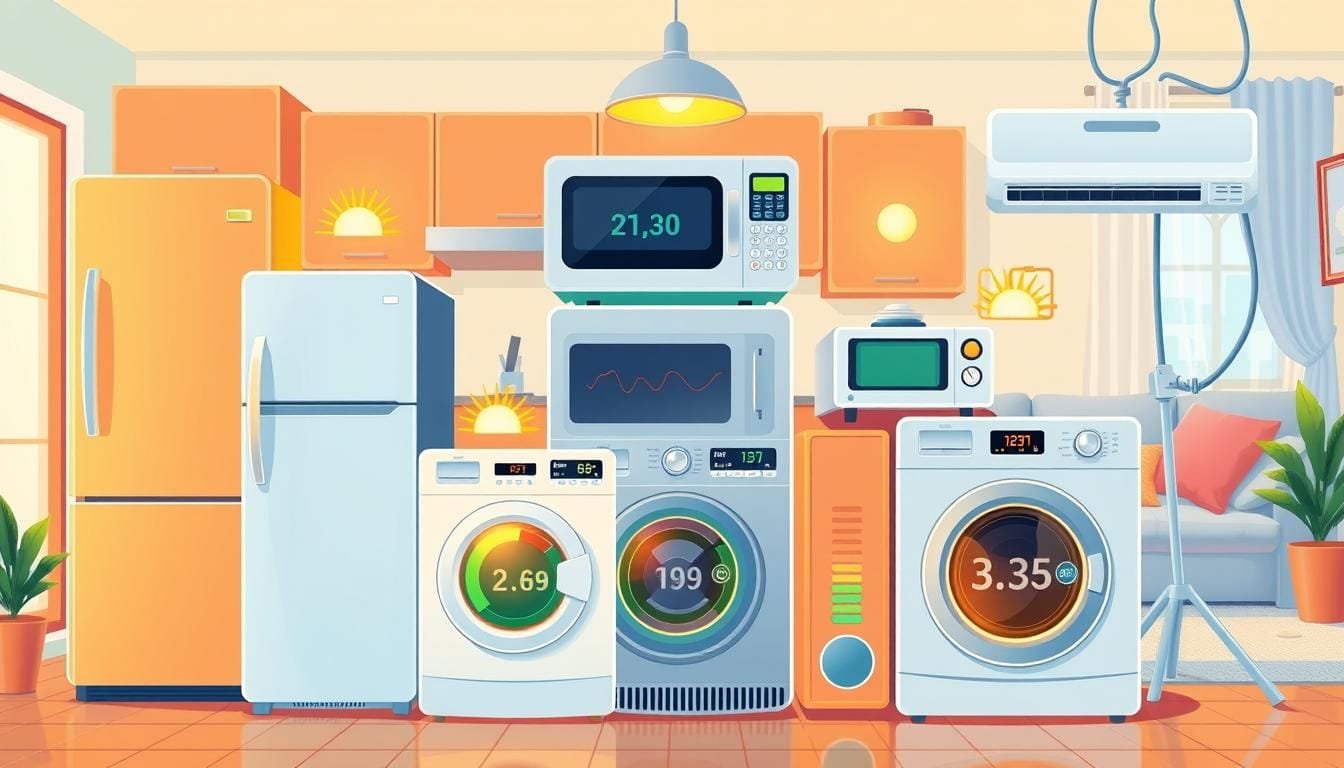Did you know the average U.S. household spends about $115 a month on electricity? A huge 35% of that energy is wasted. Knowing which appliances use the most electricity can help you save a lot of money.
High electricity usage isn’t just about big, obvious devices. Many people are surprised to find out that simple appliances also use a lot of energy. From your heating and cooling systems to kitchen gadgets and electronics, each one affects your energy use.
This guide will show you which appliances use the most electricity. It will help you find ways to use less energy and save on your bills. By knowing which appliances use the most, you can make better choices about your energy use.
Key Takeaways
- The average household wastes 35% of its monthly electricity
- Heating and cooling systems are the largest energy consumers
- Understanding appliance energy use can lead to significant cost savings
- Vampire appliances contribute to unexpected energy waste
- Strategic energy management can reduce monthly utility bills
Understanding Home Energy Consumption Basics
Energy use is key in today’s homes, affecting our bills and energy use. Knowing how appliances use electricity helps us make better choices about energy.
How Electricity Usage is Measured
Electricity is measured in watts and kilowatt-hours (kWh). This unit, named after James Watt, tracks how much energy appliances and devices use in our homes.
- 1 kilowatt = 1,000 watts
- Wattage shows how fast an appliance uses electricity
- Kilowatt-hours show the total energy used over time
Average Household Energy Consumption Statistics
Home systems use different amounts of energy. Knowing these percentages helps us find ways to save energy.
| Home System | Energy Consumption |
|---|---|
| Heating and Cooling | 54% |
| Appliances and Electronics | 23% |
| Water Heating | 16% |
| Lighting | 4% |
| Refrigeration | 4% |
Impact on Monthly Utility Bills
Appliances that use a lot of energy can raise our monthly bills. Energy efficiency is key to keeping costs down. By knowing how we use energy, we can cut down on bills.
“Knowing how much energy we use is the first step to saving on our electricity bills.” – Energy Conservation Expert
Small changes like using efficient appliances and adjusting thermostats can make a big difference. Being mindful of how we use electricity can also help lower our bills.
HVAC Systems: Your Home’s Biggest Energy Consumer
HVAC systems are the biggest energy users in our homes. They make up to 47% of all home energy use. This makes them a key area for saving energy.
The average U.S. home spends over $1,000 a year on heating and cooling. Central air conditioners use 2,000 to 5,000 watts every hour. This is a big part of our monthly electricity bills.
“Understanding your HVAC system’s energy consumption can lead to significant savings and improved home efficiency.”
- HVAC systems consume 40-50% of total home electricity
- Annual heating and cooling costs exceed $1,000 per household
- Central air conditioners use 2,000-5,000 watts hourly
There are ways to cut down on HVAC energy use. Programmable thermostats, regular maintenance, and good insulation are important. They help reduce energy waste in our homes.
Homeowners can get tax credits of up to $2,000 for installing efficient HVAC systems. This is a great reason to improve how we manage energy at home.
Water Heaters and Their Energy Impact
Water heaters are big users of household energy. They can use up to 18% of a home’s energy. This makes them key in cutting down on electricity costs and using less energy.
Knowing about the different water heaters helps homeowners save energy and money. It’s all about making smart choices.
Types of Water Heaters
- Traditional Tank Water Heaters: Continuously heat and store water
- Tankless Water Heaters: Heat water on demand
- Heat Pump Water Heaters: Transfer heat from surrounding air
- Solar Water Heaters: Use renewable solar energy
Energy-Saving Temperature Settings
Lowering your water heater’s temperature can cut down on electricity use. Changing it from 140°F to 120°F can save 4-22% of energy each year.
“Small adjustments in water heater settings can lead to substantial energy savings”
Maintenance Tips for Efficiency
| Maintenance Action | Potential Energy Savings |
|---|---|
| Regular tank flushing | Up to 5% energy reduction |
| Proper insulation | 7-16% energy savings |
| Annual professional inspection | Ensures optimal efficiency |
Heat pump water heaters are very energy-efficient. They use 50-67% less energy than traditional ones. Homes could save about $550 a year by using these systems.
Which Appliances Use the Most Electricity in Your Home
Knowing which appliances use the most electricity helps you save money. These appliances can raise your monthly bills a lot. It’s important to know which ones use the most energy in your home.
- HVAC (Heating, Ventilation, and Air Conditioning) systems
- Water heaters
- Refrigeration units
- Laundry equipment
- Lighting systems
Let’s look at how much electricity these appliances use:
| Appliance Category | Percentage of Energy Use | Annual Cost Impact |
|---|---|---|
| HVAC Systems | 47% | Highest energy consumer |
| Water Heater | 14% | Significant electricity drain |
| Washer and Dryer | 13% | Substantial energy usage |
| Lighting | 12% | Controllable with LED upgrades |
| Refrigerator | 4% | Consistent energy consumption |
*Pro tip: Reducing the energy consumption of these appliances can lead to significant savings on your electricity bill.*
When looking at which appliances use the most electricity, think about their energy rating and how often you use them. Older or inefficient appliances can use a lot more energy.
Using energy-efficient appliances, keeping them well-maintained, and being smart about how you use them can help. This can lower the energy use of these appliances.
Kitchen Appliances and Their Power Consumption
Kitchen appliances use a lot of electricity, affecting your bills and energy use. Knowing how much they use can help you save energy every day.
Refrigerators and Freezers: The Silent Energy Consumers
Refrigerators use a lot of energy, always working. They use about 162 kWh each month. This is a big part of your home’s energy use.
- Newer models with Energy Star ratings use less electricity
- Keep them well-maintained to save energy
- Setting the right temperature can also save power
Electric Ovens and Stovetops: High-Wattage Kitchen Workhorses
Electric ovens and stovetops use a lot of energy. An oven uses 2,500 watts, and a stovetop uses 1,500 watts on medium-high. Using them for an hour a day can use 75 kWh and 45 kWh each month.
| Appliance | Average Watts | Monthly kWh |
|---|---|---|
| Electric Oven | 2,500W | 75 kWh |
| Stovetop | 1,500W | 45 kWh |
Dishwashers and Small Appliances: Hidden Energy Consumers
Even small appliances can add up in energy costs. A dishwasher uses 1,200 to 1,500 watts per cycle.
“Every watt counts when it comes to home energy efficiency” – Energy Conservation Expert
- Run full loads to save energy
- Choose high-energy-rated appliances
- Turn off small appliances when not using them
Laundry Room Energy Usage

Laundry appliances use a lot of energy in homes. Washers and dryers use about 5% of your home’s energy. They use around 3,045 watts together. Knowing how they use energy can help lower your electricity bills.
Different washers and dryers use different amounts of energy. Front-loading washers are usually more energy-efficient than top-loading ones. Gas dryers also use less energy than electric ones.
“Smart laundry practices can substantially reduce your household’s energy consumption”
Energy-Saving Laundry Strategies
- Use cold water for washing clothes
- Optimize load sizes to maximize efficiency
- Air-dry clothes when possible
- Clean lint filters regularly
- Use moisture-sensing settings on dryers
Doing laundry can be expensive. An average load costs about $0.75. That’s $22.50 for 30 loads a month. Using energy-efficient ways can cut down these costs a lot.
| Laundry Appliance | Average Energy Consumption | Monthly Cost |
|---|---|---|
| Washer | 500 watts | $10.80 |
| Dryer | 2,545 watts | $11.70 |
Using energy-saving techniques in laundry can greatly reduce electricity use. It also helps lower your monthly utility bills.
Understanding Vampire Energy and Standby Power
There’s a hidden energy drain in your home. It quietly raises your electricity bills. This happens because of power-hungry appliances that use energy even when they seem off. Vampire energy, or standby power, is a big source of energy waste in today’s homes.
The Invisible Energy Culprits
Many electronic devices keep using power even when not in use. The National Resources Defense Council says vampire power costs homes about $165 a year. This adds up to a huge $19 billion in energy waste across the country.
- Televisions (even smart TVs)
- Computer chargers
- Kitchen appliances with digital displays
- Game consoles
- Smartphone chargers
Impact on Electricity Bills
Standby power can be up to 10% of your monthly electricity use. Appliances plugged in but not used can cost around $200 a year in extra energy costs.
| Device | Average Standby Power Consumption |
|---|---|
| Smart TV | 25-30 watts |
| Computer Charger | 2-10 watts |
| Gaming Console | 10-20 watts |
Energy-Saving Tips to Reduce Standby Power
Simple steps can greatly reduce vampire energy use:
- Use smart power strips
- Unplug devices when not in use
- Choose ENERGY STAR certified appliances
- Use power management settings
“By addressing vampire energy, households can save money and reduce their carbon footprint.” – Energy Conservation Expert
Managing standby power is an easy way to lower your electricity bills. It also helps make your home more energy efficient.
Lighting Systems and Energy Efficiency
Lighting is key to saving energy at home. About 4% of home electricity use is for lighting. Making smart choices can cut down your bills a lot.
There are different bulbs with different energy uses:
- Incandescent bulbs: Least energy-efficient option
- Compact Fluorescent Lights (CFL): More efficient than incandescent
- LED bulbs: Most energy-efficient lighting technology
LED light bulbs are a game-changer for energy efficiency. They use 75% less energy than old bulbs and last up to 25 times longer. This means big savings on your bills and less need to replace bulbs.
| Bulb Type | Energy Consumption | Lifespan |
|---|---|---|
| Incandescent | High | Short (1,000 hours) |
| CFL | Moderate | Medium (8,000 hours) |
| LED | Low | Long (25,000 hours) |
Smart lighting can make your home even more energy-efficient. Here are some tips:
- Install dimmer switches
- Use natural light when possible
- Choose task lighting for specific areas
- Utilize motion sensors in less-frequented spaces
“Smart lighting isn’t just about saving energy—it’s about creating a more efficient and sustainable home environment.” – Energy Efficiency Expert
The Department of Energy says lighting standards have really improved. In 2000, they covered less than 5% of energy use. By 2015, it was over 60%. By choosing energy-efficient bulbs, homes can help save a lot of energy nationwide.
Entertainment Systems and Electronic Devices
Electronic devices are key in today’s homes, using a lot of energy. Big items like TVs, gaming consoles, and office gear can take up to 5% of a home’s power.

Knowing which devices use the most power helps us choose better, saving energy.
TV and Gaming Consoles Energy Impact
Modern TVs and gaming consoles use a lot of power. Here are some important facts:
- Televisions in standby mode use an average of 13 watts
- Annual standby cost for a single TV is about $15.75
- New TVs use less power in standby, from 0.5 to 3 watts
- Game consoles can use up to 11 watts in instant-on mode
Computers and Home Office Equipment
Home office gear also uses a lot of energy:
- Laptop computers in standby use about 7.1 watts
- Desktop computers idle at around 9.5 watts
- Annual standby costs are $9 to $12 for computers
- Audio devices like soundbars average 7.5 watts in standby mode
“Standby power accounts for 1% of global carbon emissions” – Lawrence Berkeley National Laboratory
To cut energy use, turn off devices or use smart power strips. They stop energy draw when not in use.
Smart Home Technology for Energy Management
Smart home technology has changed how we save energy. It lets homeowners control their energy use in new ways. This technology is making it easier to lower our electricity bills.
Today’s smart home devices use advanced tech to watch and control energy use. They have sensors and smart algorithms. These tools help cut down on energy waste.
“Smart home technologies can help homeowners reduce energy bills by up to 15% through intelligent management and monitoring.” – Energy Efficiency Experts
- Smart thermostats with geofencing technology
- Energy monitoring systems
- Automated smart plugs
- Intelligent lighting controls
Smart home energy management offers many benefits. You can track your energy use in real-time. It also schedules your devices and gives you tips to save energy. These tools can save up to 40% of energy compared to old homes.
| Smart Device | Energy Savings | Average Cost |
|---|---|---|
| Smart Thermostat | 10-15% | $200-$250 |
| Smart Plugs | 5-10% | $20-$50 |
| Energy Monitoring System | 15-25% | $100-$300 |
By 2026, almost 2 billion connected devices will be in homes. Smart home tech is getting cheaper and more common. It helps us save money and protect the environment.
Time-of-Use Rates and Peak Hours
Understanding electricity bills can be complex, thanks to time-of-use (TOU) rate plans. These plans are changing how we use energy and cut down costs.
Utility companies now use dynamic pricing. They charge different rates based on the time of day. This helps balance demand and promotes better energy use.
Understanding Peak Pricing
Peak hours are the busiest times, usually from 2 PM to 6 PM. Electricity rates go up a lot during these times:
- East Coast peak hours: 2 PM to 6 PM in summer
- California peak hours: 4 PM to 9 PM on weekdays
- Summer rates are higher because of more air conditioning use
Optimal Usage Times
Smart users can save by doing energy-heavy tasks during off-peak hours. Here are some tips:
- Run big appliances at night or early morning
- Use programmable thermostats to save on cooling during peak
- Think about getting home batteries for energy storage
“By understanding and adapting to time-of-use rates, homeowners can potentially save up to $50 per month on electricity costs.”
Some providers offer special plans to make energy cheaper. For example, solar panel owners can make electricity during off-peak hours. They can store it for when rates are higher.
Pro tip: Check with your local utility company to understand their specific time-of-use rate structure and optimal energy consumption times.
Energy Star Ratings and Appliance Selection

Choosing energy-efficient appliances can cut down your home’s electricity use a lot. The ENERGY STAR program, started by the U.S. Environmental Protection Agency in 1992, helps find the most efficient appliances. It guides consumers in picking the right ones.
ENERGY STAR certified products are top in energy saving. They use 10-20% less energy than the minimum federal standards. This means big savings for you and the planet. It also helps you make smart choices when buying new appliances.
“ENERGY STAR products are your gateway to smarter, more efficient home energy management.”
Key Benefits of ENERGY STAR Appliances
- Reduce energy consumption by 10-20%
- Lower utility bills
- Minimize environmental impact
- Extended appliance lifespan
The savings are huge. ENERGY STAR appliances can cut your bills by a lot. Here’s how much you could save:
| Appliance | Lifetime Savings |
|---|---|
| Washer | $300 |
| Dryer | $210 |
| Refrigerator | $310-$440 |
Pro tip: Always look for the ENERGY STAR label when buying new appliances. It ensures you get the most energy savings.
ENERGY STAR has made a huge difference. It has saved over 4 trillion kilowatt-hours of electricity and 3.5 billion metric tons of greenhouse gases. In 2018, it saved $35 billion in energy costs. This shows how important it is to choose energy-efficient appliances.
Seasonal Energy Usage Patterns
Knowing how energy use changes with the seasons helps homeowners save on their electricity bills. Each season has its own energy challenges, with big changes in energy use across the U.S.
Energy use changes a lot based on where you live and the weather. Here are some interesting facts about how homes use energy:
- Southern households use up to 15,000 kWh a year
- Northeastern homes use about 7,000 kWh yearly
- Midwestern homes use around 10,000 kWh
Heating and cooling systems use the most energy, making up almost 50% of home energy use. Summer and winter months really affect how much electricity we use, with different patterns for each season.
| Season | Energy Consumption Peak | Average kWh Usage |
|---|---|---|
| Summer | Daytime hours | 14,000 kWh |
| Winter | Morning/Evening | 10,500 kWh |
The U.S. Department of Energy suggests keeping thermostats at 68°F in winter and 78°F in summer for best energy use.
There are smart ways to handle energy use in different seasons:
- Get energy-saving HVAC systems
- Use smart thermostats
- Make sure your home is well-insulated
- Use plants to help keep your home cool
By understanding these patterns, homeowners can cut down on energy use and lower their bills all year.
Alternative Energy Solutions and Solar Options
Looking into alternative energy can change the game for homeowners. It helps them save on energy and cut down on electricity costs. Solar power stands out as a top choice for green home energy.
Solar tech brings big benefits to today’s homes. A 7 kW solar system can make 20 to 35 kilowatt-hours of electricity every day. This cuts down on utility bills a lot. The cost to start is about $21,000, but the long-term savings are worth it.
“Solar power becomes free after the initial panel installation, providing continuous energy without recurring costs.”
What makes solar energy great includes:
- Big cuts in monthly electricity bills
- Less carbon footprint
- Government incentives and tax credits
- Higher home value
Homeowners can also look at other energy options:
- Geothermal heat pumps: Up to three times more efficient than air-source heat pumps
- Wind energy systems: Small setups that add extra electricity
- Solar hot water systems: Can meet up to 50% of hot water needs
By choosing alternative energy, homeowners can change how they use energy. They save a lot in the long run and help the planet too.
Conclusion
Knowing which appliances use the most electricity is key for saving money on bills. We found that HVAC systems, water heaters, and big kitchen appliances eat up a lot of energy. By using smart tips, you can cut down your yearly electricity costs a lot.
Upgrading to energy-saving models and keeping appliances in good shape helps a lot. Also, being careful about how you use them can save you money. New tech lets you track and cut down on energy use at home. Things like smart thermostats, LED lights, and Energy Star appliances are great choices for saving money and the planet.
Improving energy efficiency doesn’t mean big changes. It’s about making small, smart steps. First, find out which appliances use the most energy. Then, make a plan to use less. Simple changes in how you live and smart tech choices can make a big difference.
Being smart about home energy use helps you save money and helps the planet. By learning and acting on how to use less energy, you’re doing your part for the environment. This is good for you and for the country.

